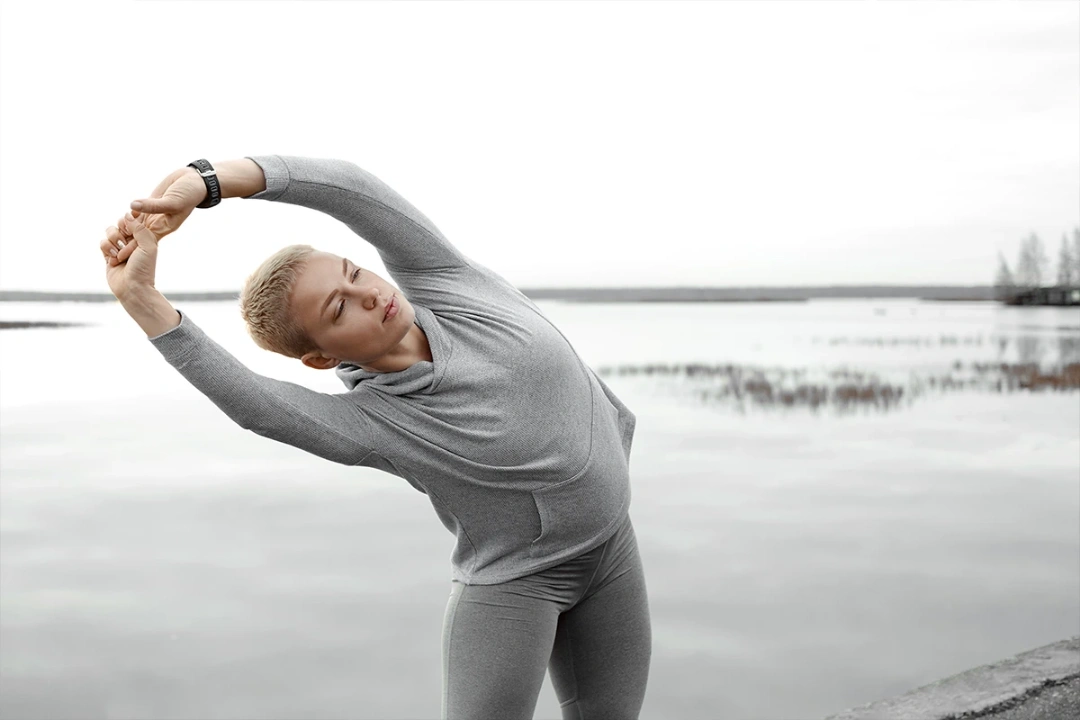Back pain doesn’t just slow you down—it can sideline your daily routine, from powering through your workday to crushing your workouts. Often, the quadratus lumborum—a deeply tucked, unsung hero (or villain) of the lower back—plays a pivotal role in that nagging discomfort. When this muscle tightens or becomes overworked, it can throw your whole body out of sync.
In this article, we’ll dive into the most effective quadratus lumborum stretches, helping you regain control over your back health and rediscover your freedom of movement.
Why Stretch the Quadratus Lumborum?
The Quadratus Lumborum (QL), a deep muscle in your lower back, plays a vital role in spine stability, posture, and movement. Connecting the pelvis to the lower ribs and lumbar vertebrae, the QL assists with side bending, core support, and breathing. Due to its central function, it often endures significant strain during everyday activities, making it a common source of lower back pain.
Tightness in the QL can result from prolonged sitting, poor posture, or repetitive movements, leading to localized pain, reduced mobility, and even referred pain in the hips, thighs, or abdomen. This overactivity often compensates for weaker surrounding muscles, exacerbating discomfort and increasing the risk of chronic issues if left unaddressed.
Stretching the QL is a highly effective way to release tension, improve flexibility, and alleviate pain. Regular stretching not only restores balance and mobility but also enhances core stability and prevents future injuries.
“When I started incorporating QL stretches into my routine, I noticed a huge difference. It really helps counteract the effects of sitting for long periods and has made a big impact on my overall back health.”
Effective Quadratus Lumborum Stretches for Back Pain
 1. Side-Lying Quadratus Lumborum Stretch
1. Side-Lying Quadratus Lumborum Stretch
The Side-Lying Quadratus Lumborum Stretch not only alleviates discomfort but also improves flexibility and promotes relaxation, making it an excellent addition to your routine.
Benefits of the Side-Lying Quadratus Lumborum Stretch:
-
Releases Lower Back Tension: Targets the QL directly, relieving built-up stress and discomfort.
-
Improves Flexibility: Enhances the range of motion in your torso and lower back, reducing stiffness.
-
Promotes Relaxation: Encourages deep breathing, which helps calm the nervous system and improve stretch effectiveness.
-
Supports Alignment: Helps correct imbalances caused by prolonged sitting or poor posture.
How to Perform the Side-Lying Quadratus Lumborum Stretch:
-
Lie on your side on a firm but comfortable surface, such as a yoga mat.
-
Fully extend your bottom leg while bending your top leg, resting the foot of your top leg just in front of your bottom knee.
-
Stretch your top arm overhead, reaching toward the floor on the opposite side, allowing your torso to gently curve into a side-bending position.
-
Place your bottom arm under your head for support or extend it outward for added balance.
-
Hold this position for up to 30 seconds, focusing on deep, steady breathing to enhance relaxation and the effectiveness of the stretch.
-
Switch sides and repeat the process on the other side.
2. Child’s Pose with Side Reach
![]() The Child’s Pose with Side Reach is ideal for releasing lower back tension and enhancing flexibility.
The Child’s Pose with Side Reach is ideal for releasing lower back tension and enhancing flexibility.
Benefits of the Child’s Pose with Side Reach:
-
Releases Lower Back Tension: Gently stretches the QL and surrounding muscles, relieving discomfort.
-
Enhances Flexibility: Improves mobility in the lower back and sides of the torso.
-
Promotes Relaxation: Encourages deep breathing, reducing stress and supporting muscle elongation.
-
Improves Posture: Helps counteract the effects of poor alignment or prolonged sitting.
How to Perform the Child’s Pose with Side Reach:
-
Begin by kneeling on the floor and sitting back onto your heels with your knees comfortably apart.
-
Extend your arms forward and lower your torso toward the ground, resting your forehead on the mat in the standard Child’s Pose position.
-
Slowly walk both hands to one side of your body, keeping them on the floor. This side-reaching motion creates a gentle stretch along the opposite side of your lower back, targeting the QL.
-
Hold the position for up to 30 seconds, focusing on deep, controlled breathing. Expand your ribcage with each inhale to deepen the stretch.
-
Return to the center, then repeat the movement on the other side.
3. Standing Side Stretch
The Standing Side Stretch is particularly helpful for improving lateral flexibility and relieving discomfort caused by prolonged sitting or poor posture.
Benefits of the Standing Side Stretch:
-
Relieves Lower Back Tension: Targets the QL to release tightness and reduce discomfort.
-
Improves Lateral Flexibility: Enhances the range of motion in your torso and sides.
-
Supports Core Stability: Engages core muscles to maintain proper alignment and stability.
-
Counteracts Sedentary Habits: Helps offset the effects of sitting for extended periods.
How to Perform the Standing Side Stretch:
-
Stand with your feet hip-width apart, distributing your weight evenly.
-
Place one hand on your hip for support and extend your opposite arm overhead, reaching toward the ceiling.
-
Gently lean to the side of your supporting hand, creating a stretch along the opposite side of your torso. Keep your chest open and facing forward to avoid twisting.
-
Engage your core to maintain stability and prevent overextension.
-
Hold the stretch for up to 30 seconds, then return to the starting position. Repeat on the other side.
4. Seated Quadratus Lumborum Stretch
The Seated Quadratus Lumborum (QL) requires minimal space and no equipment, making it an excellent choice for relieving lower back tension and enhancing lateral flexibility.
Benefits of the Seated Quadratus Lumborum Stretch:
-
Eases Lower Back Tension: Releases tightness caused by prolonged sitting or poor posture.
-
Improves Lateral Flexibility: Enhances the range of motion for more comfortable bending and reaching.
-
Supports Spinal Alignment: Gently lengthens the QL and surrounding muscles, promoting better posture.
How to Perform the Seated Quadratus Lumborum Stretch:
-
Start with Proper Posture: Sit on a flat surface or chair with your back straight and feet flat on the floor. Ensure you are balanced evenly on both sitting bones.
-
Position Your Body: Place one hand on the seat or surface next to you for support. Extend your opposite arm overhead, reaching toward the ceiling.
-
Initiate the Stretch: Gently bend your upper body toward the side where your supporting hand is placed. Keep your chest open and avoid collapsing forward. Focus on feeling the stretch along the side of your torso, particularly in your lower back.
-
Hold and Release: Maintain the stretch for up to 30 seconds, breathing deeply to encourage relaxation. Slowly return to the starting position and switch sides.
5. Twisting Quadratus Lumborum Stretch
![]() The Twisting Quadratus Lumborum (QL) Stretch is a highly effective exercise that combines a gentle twisting motion to target the QL muscle while engaging surrounding muscles. This stretch enhances spinal mobility and alleviates tension in the lower back, making it an excellent addition to any back care routine.
The Twisting Quadratus Lumborum (QL) Stretch is a highly effective exercise that combines a gentle twisting motion to target the QL muscle while engaging surrounding muscles. This stretch enhances spinal mobility and alleviates tension in the lower back, making it an excellent addition to any back care routine.
Benefits of the Twisting Quadratus Lumborum Stretch:
-
Improves Spinal Mobility: Promotes rotational flexibility, making it easier to twist and turn in daily activities.
-
Releases Lower Back Tension: Loosens the QL and surrounding muscles, reducing discomfort caused by tightness.
-
Eases Lower Back Pain: Provides relief from discomfort associated with prolonged sitting or repetitive movements.
How to Perform the Twisting Quadratus Lumborum Stretch:
-
Start in Position: Sit on the floor with your legs extended straight in front of you.
-
Set Up the Twist: Bend your right knee and cross your right foot over your left thigh, placing it flat on the ground.
-
Place Your Hands: Position your right hand on the floor behind you for support. Place your left elbow outside your right knee, pressing gently to enhance the twist.
-
Perform the Twist: Rotate your torso to the right, keeping your spine tall and aligned. Focus on feeling the stretch in your lower back and sides.
-
Hold and Breathe: Maintain the position for up to 30 seconds, breathing deeply to maximize relaxation.
-
Repeat: Slowly return to the center and switch sides.
Maintaining a consistent routine and performing stretches correctly can sometimes be challenging without proper guidance. This is where a tool like WeStretch can make all the difference. Designed to guide you through tailored stretching routines, WeStretch ensures that you’re targeting the right muscles with proper form, including the QL.
Tips for Effective Quadratus Lumborum Stretching
To ensure your Quadratus Lumborum (QL) stretches are both safe and effective, proper preparation is essential. Begin with a light warm-up to increase blood flow and loosen your muscles, reducing the risk of strain or injury. Simple activities like brisk walking, dynamic stretches, or gentle yoga movements can help prime your body for the stretches.
While performing the stretches, focus on maintaining proper form and alignment. A neutral spine, controlled movements, and attention to posture ensure that the QL is effectively targeted without overloading other muscles or joints. Always listen to your body, stretching only to a point of mild tension and stopping if you experience sharp or persistent pain.
Consistency is key for long-term benefits. Integrate QL stretches into your routine several times a week—or even daily for significant tension. Combined with steady, controlled breathing to relax your muscles, these stretches will enhance flexibility, reduce discomfort, and support better back health over time.
Exercise Smarter with WeStretch: Your All-in-One Stretching Assistant
A consistent full-body stretching routine is essential for improving flexibility, supporting injury prevention, and enhancing overall well-being. Carefully following simple yet effective stretches targeting the hamstrings, hip flexors, back, quads, chest, and shoulders, individuals of any fitness level can reap the benefits.
Regular stretching, with attention to proper form and consistency, can help you move more freely, recover faster, and feel better in everyday activities.
Looking for a way to add some fun to your stretching routine? Check out WeStretch—an app that’s like your own personal stretch coach! With tailored plans, easy-to-follow demos, and progress tracking, it’s got everything you need to keep you limber and on point. Ready to get flexible? Sign up today and let’s get stretching!
 FAQ
FAQ
How do you release tight quadratus lumborum?
To release a tight quadratus lumborum (QL), incorporate targeted stretches like the side-lying QL stretch, standing side bend, or seated spinal twist.
What causes a tight quadratus lumborum?
A tight quadratus lumborum (QL) can result from poor posture, prolonged sitting, repetitive movements, uneven weight-bearing, or overuse during activities like lifting or twisting.
What emotions are stored in the QL?
The quadratus lumborum (QL) often stores emotions like stress, fear, and anxiety because of its role in stabilizing the body during tension.
How long does a QL strain take to heal?
A quadratus lumborum (QL) strain typically takes 4 to 6 weeks to heal, depending on the severity of the injury and individual recovery factors.
What are the best quadratus lumborum stretches for beginners?
The best quadratus lumborum stretches for beginners include the Side-lying QL Stretch and the Seated Side Stretch.






